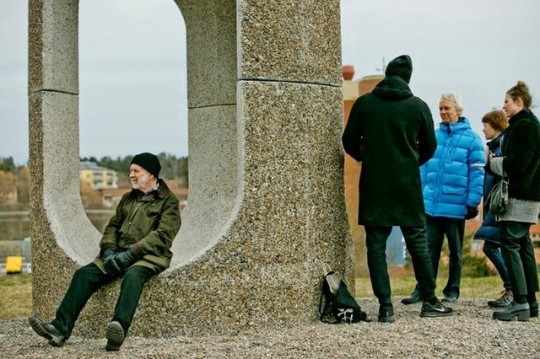Can constant communication alleviate depression in stressed individuals?
These projects illustrate the phenomena of ‘the programming of human behavior using architecture’.
On the basis of: What - How - Why - Where - When - Problem Set - Site/Prototype - Site Study - Concept - User Behaviors - Design - Conclusions. They are an attempt to illustrate certain observed notions between human emotions and the spaces we inhibit, mostly through the practice of creating architectural spaces by Kushal Samant.
Housing for Kalejdohill, Kvarnbacken, Jakobsberg.

This project was a competition entry to design a story for a public park for Kalejdohill. It focused on story designing as a tool for spacemaking.
We remember places because of the stories we tell about them. The sunset was amazing over the Grand Canyon one afternoon in 1992. The riots almost burned down Syntagma Square in Athens in 2008, and even if we only saw it on TV, we still remember the square like that. In Hong Kong we saw Filipino nannies having Sunday tea in cardboard boxes in a space that was was never meant to be public, but then suddenly it was. When stories shape our perception of public space we might assume that the spaces themselves generate the stories that we will later remember them by. Something in their design might trigger events that lead to human interaction or forces of nature joining to make a memorable moment.
But could we imagine reversing that process? Could we begin thinking about public space by designing stories that could potentially take place there, and therefore design our memories or even the physical reality of the place before that space exists?
The competition explored the potential of stories in architecture to open up unexpected paths and ideas in the design of public space. From linear narratives to multiple narratives that overlap, to the reinvention of our past, and new descriptions of the present, there is a great potential for storytelling in architecture. Stories are embedded in public space, from the history, to the day and life cycle of a space, as they change throughout the day and are altered and perceived radically different in its lifetime.
The stories could involve elements from the history of the site such as the ancient viking burial sites, or the mill that sat on the highest point and burned down several times over the last decades. They could involve the lives of future inhabitants, the reality of living in a suburb of Stockholm, or the fantasy of chasing that elusive Pokemon in the newly formed public space of Kalejdohill. The stories could be personal, walking your dog one morning and seeing the strangest bird, or they could be communal, a massive concert where you fell in love or a force of nature that lead you there.
‘Design a story for a public park announcements’.
Kvarnbacken.
Kvarnbacken, the hill close to the Jakobsberg train station felt like a shadow. As he moved across the plains thinking of all that had happened to him, searching for joy. He wanted to find a map of this place. He had never felt so lost in a place where he belonged. They told him about the ancient Vikings. How fierce were they? He knew not! He knew nothing about his past. Ever since he was child, he had secretly visited the burial sites. He never wanted his child to be scared of the glorious past that his ancestry held. He wanted burial sites to be free; eventful.
Yet no one heard his cry. He ran along the winding path. As each led to another, and he felt lost. He knew inside of him that all of his running would take him back to the place where he came from, as if this was all a maze. The dark and dusky evening wind chilled inside of him. A sweat broke over his face, a chill ran down his back. An ephemeral spirit beckoning him to seek. Seek all that was beyond his curiosity. Yet he could not feel it. He would refuse to see it.
He wished that these high walls would disappear. Yes there was a beauty in them. From the material to the texture and all the attributes a physical and materialistic world could apply to them. But labels were not his thing. He wanted feelings. Burning hot. In a flash he felt the air rise, the heat burning through his skin. He did not know what was happening. He wanted more of this pain, this uncertainty, but all that his eyes could see was nothing. It is his mind that is seeing now.
Feeling the flames beyond the closed eyelids, as if he were blind to all else but the pain as he rose to height. He knew nothing else. If he was going up the hill to where the path would loop his way like a serpent around Kvarnbacken. Time froze. He did not want to leave the kintsukuroi of these burning flames. He believed they made him beautiful. But he had to pause. All the pain that the mill had given his people, had to be brought down. He did not mean broken, for anything new was too painful for his lifetime to take. All these places were his memories, the last shred of them.He was a local of Stockholm, and he did loved the tourists seeking more and more of what was there. When will anyone ever be satisfied? Yes! This is what he started to seek. He wished to change purpose. He wanted the silence to be replaced with voices of joy. He heard guitars, and a faint hush of the crowd as those who had wandered far from home, walked past him seeking solace in the same land. His streets, where he played. A place where his children would play some day. A space for anyone who wished to seek peace. Away from their distressed home and stories.
He sat down on a brazen obsidian stone. Though they were not found anymore after the polynesians left. He sat down for his body to cool down. He heard drum rolls as the people around him started rushing towards the sound. For him, he could not pinpoint it, it seemed to be coming from the heavens, but everyone around him knew. He did not. Maybe he was in an invisible ambisonic room. For he could see them, for they brushed past him. He knew not what was all of this fantasy. Just like his grandfather spoke of the trams that rolled across the european streets during the world wars. His lifetime seemed more like his grandpa’s.
He felt the same uncertainty, the same dark clouds and with the difference of technology. All the young kids were instagraming, facebook-ing, and doing all these things that gave them joy. But to him, what were they? More than statues? Or maybe just statues filled with life. He wanted to break all that was everyone’s reality. He wanted the past to overpower this falsehood of his present, for he knew not what his future held! Then the obsidian turned to a soft rocking chair and he could see that he was seeing from his grandfather’s eyes, the soft rock rumble as his granny made some coffee for herself. How beautiful had life been. That he had got to move, to travel, to run, and hide, and to play with the wind and the sands, the grass and seas, how absurd were these elements. Maybe it was collective human nature that made coffee cold and public spaces out of the unseen. In an age when freedom was exploiting a reason to hide, a reason to be with ourselves, he got up from his grandpa’s chair, and was with himself now.
He walked out of the door and ran. He ran to find new feelings, thinking of that girl who texted him on Instagram, and the girl who looked like the Instagram women. He ran to find new experiences, beating down the path. As the drum rolls now fastened, he found himself to witness an unbelievable fact, that the drums were coming from him, and he was the drummer; running to the beat of his own heart. Yet he felt cliche on this once lost hill called Kvarnbacken, the hill close that to the Jakobsberg train station.

Superbench by Philippe Malouin.